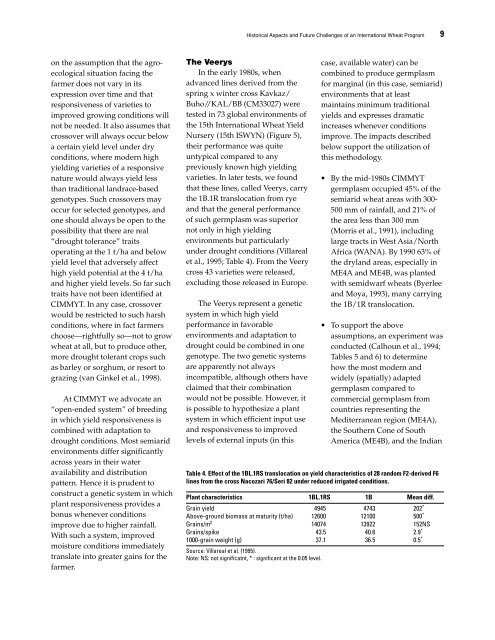Septoria and Stagonospora Diseases of Cereals - CIMMYT ...
Septoria and Stagonospora Diseases of Cereals - CIMMYT ...
Septoria and Stagonospora Diseases of Cereals - CIMMYT ...
You also want an ePaper? Increase the reach of your titles
YUMPU automatically turns print PDFs into web optimized ePapers that Google loves.
on the assumption that the agroecological<br />
situation facing the<br />
farmer does not vary in its<br />
expression over time <strong>and</strong> that<br />
responsiveness <strong>of</strong> varieties to<br />
improved growing conditions will<br />
not be needed. It also assumes that<br />
crossover will always occur below<br />
a certain yield level under dry<br />
conditions, where modern high<br />
yielding varieties <strong>of</strong> a responsive<br />
nature would always yield less<br />
than traditional l<strong>and</strong>race-based<br />
genotypes. Such crossovers may<br />
occur for selected genotypes, <strong>and</strong><br />
one should always be open to the<br />
possibility that there are real<br />
“drought tolerance” traits<br />
operating at the 1 t/ha <strong>and</strong> below<br />
yield level that adversely affect<br />
high yield potential at the 4 t/ha<br />
<strong>and</strong> higher yield levels. So far such<br />
traits have not been identified at<br />
<strong>CIMMYT</strong>. In any case, crossover<br />
would be restricted to such harsh<br />
conditions, where in fact farmers<br />
choose—rightfully so—not to grow<br />
wheat at all, but to produce other,<br />
more drought tolerant crops such<br />
as barley or sorghum, or resort to<br />
grazing (van Ginkel et al., 1998).<br />
At <strong>CIMMYT</strong> we advocate an<br />
“open-ended system” <strong>of</strong> breeding<br />
in which yield responsiveness is<br />
combined with adaptation to<br />
drought conditions. Most semiarid<br />
environments differ significantly<br />
across years in their water<br />
availability <strong>and</strong> distribution<br />
pattern. Hence it is prudent to<br />
construct a genetic system in which<br />
plant responsiveness provides a<br />
bonus whenever conditions<br />
improve due to higher rainfall.<br />
With such a system, improved<br />
moisture conditions immediately<br />
translate into greater gains for the<br />
farmer.<br />
Historical Aspects <strong>and</strong> Future Challenges <strong>of</strong> an International Wheat Program 9<br />
The Veerys<br />
In the early 1980s, when<br />
advanced lines derived from the<br />
spring x winter cross Kavkaz/<br />
Buho//KAL/BB (CM33027) were<br />
tested in 73 global environments <strong>of</strong><br />
the 15th International Wheat Yield<br />
Nursery (15th ISWYN) (Figure 5),<br />
their performance was quite<br />
untypical compared to any<br />
previously known high yielding<br />
varieties. In later tests, we found<br />
that these lines, called Veerys, carry<br />
the 1B.1R translocation from rye<br />
<strong>and</strong> that the general performance<br />
<strong>of</strong> such germplasm was superior<br />
not only in high yielding<br />
environments but particularly<br />
under drought conditions (Villareal<br />
et al., 1995; Table 4). From the Veery<br />
cross 43 varieties were released,<br />
excluding those released in Europe.<br />
The Veerys represent a genetic<br />
system in which high yield<br />
performance in favorable<br />
environments <strong>and</strong> adaptation to<br />
drought could be combined in one<br />
genotype. The two genetic systems<br />
are apparently not always<br />
incompatible, although others have<br />
claimed that their combination<br />
would not be possible. However, it<br />
is possible to hypothesize a plant<br />
system in which efficient input use<br />
<strong>and</strong> responsiveness to improved<br />
levels <strong>of</strong> external inputs (in this<br />
case, available water) can be<br />
combined to produce germplasm<br />
for marginal (in this case, semiarid)<br />
environments that at least<br />
maintains minimum traditional<br />
yields <strong>and</strong> expresses dramatic<br />
increases whenever conditions<br />
improve. The impacts described<br />
below support the utilization <strong>of</strong><br />
this methodology.<br />
• By the mid-1980s <strong>CIMMYT</strong><br />
germplasm occupied 45% <strong>of</strong> the<br />
semiarid wheat areas with 300-<br />
500 mm <strong>of</strong> rainfall, <strong>and</strong> 21% <strong>of</strong><br />
the area less than 300 mm<br />
(Morris et al., 1991), including<br />
large tracts in West Asia/North<br />
Africa (WANA). By 1990 63% <strong>of</strong><br />
the dryl<strong>and</strong> areas, especially in<br />
ME4A <strong>and</strong> ME4B, was planted<br />
with semidwarf wheats (Byerlee<br />
<strong>and</strong> Moya, 1993), many carrying<br />
the 1B/1R translocation.<br />
• To support the above<br />
assumptions, an experiment was<br />
conducted (Calhoun et al., 1994;<br />
Tables 5 <strong>and</strong> 6) to determine<br />
how the most modern <strong>and</strong><br />
widely (spatially) adapted<br />
germplasm compared to<br />
commercial germplasm from<br />
countries representing the<br />
Mediterranean region (ME4A),<br />
the Southern Cone <strong>of</strong> South<br />
America (ME4B), <strong>and</strong> the Indian<br />
Table 4. Effect <strong>of</strong> the 1BL.1RS translocation on yield characteristics <strong>of</strong> 28 r<strong>and</strong>om F2-derived F6<br />
lines from the cross Nacozari 76/Seri 82 under reduced irrigated conditions.<br />
Plant characteristics 1BL.1RS 1B Mean diff.<br />
Grain yield 4945 4743 202 *<br />
Above-ground biomass at maturity (t/ha) 12600 12100 500 *<br />
Grains/m2 14074 13922 152NS<br />
Grains/spike 43.5 40.6 2.9 *<br />
1000-grain weight (g) 37.1 36.5 0.5 *<br />
Source: Villareal et al. (1995).<br />
Note: NS: not significatnt, * : significant at the 0.05 level.









